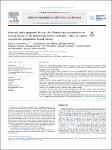Mucosal and cutaneous Human Papillomavirus seroprevalence among adults in the prevaccine era in Germany — Results from a nationwide population-based survey
Loenenbach, Anna D.
Poethko-Müller, Christina
Pawlita, Michael
Thamm, Michael
Harder, Thomas
Waterboer, Tim
Schröter, Juliane
Deleré, Yvonne
Wichmann, Ole
Wiese-Posselt, Miriam
Background
Human Papillomavirus (HPV) vaccination of girls was introduced in Germany in 2007. However, data on the distribution of vaccine-relevant HPV types in the general population in Germany in the prevaccine era are limited.
Methods
Serum samples collected during the German National Health Interview and Examination Survey 1998 (GNHIES98), a nationally representative study including men and women aged 18–79 years, were tested for antibodies to 19 mucosal and cutaneous HPV types. Multivariable regression models were developed to identify associations between demographic and behavioral characteristics and HPV seropositivity.
Results
Of the 6517 serum samples tested, almost a quarter was seropositive for at least one of the nine HPV vaccine types with no clear age-pattern. HPV-6 and HPV-59 were the most common mucosal types, while HPV-1 and HPV-4 were the most common cutaneous HPV types. Factors independently associated with HPV-16 seroprevalence were seropositive to other sexually transmitted infections and lifetime number of sex partners, as well as urbanity (only among females).
Conclusions
Prevalence of naturally acquired antibodies to HPV types which can be prevented by vaccination is high in both sexes and all age groups. These data can serve as baseline estimates to evaluate the population-level impact of the current vaccination strategy.
Dateien zu dieser Publikation

